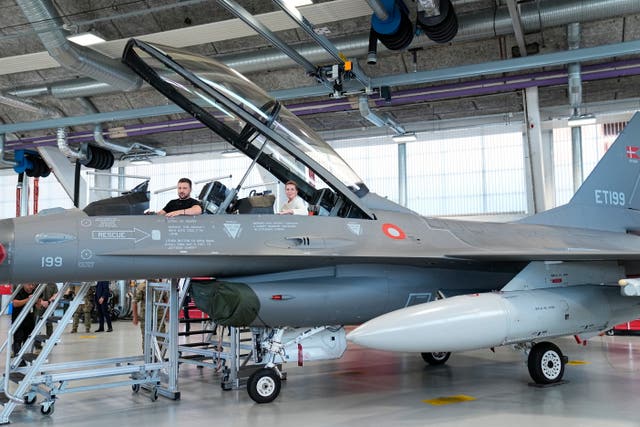
US experts have joined a Ukrainian investigation into why an F16 warplane that Ukraine received from its Western partners crashed earlier this week during a Russian bombardment, the country’s air force commander said on Friday.
Meanwhile, a Russian attack on the north-eastern city of Kharkiv using powerful plane-launched glide bombs killed five people, including a 14-year-old girl on a playground, and wounded 47 others, regional governor Oleh Syniehubov said.
The bombs struck five locations across the city, which had a pre-war population of about 1.4 million people, the governor said.
One of the bombs hit a 12-storey apartment block, setting the building ablaze and trapping at least one person on an upper floor. Emergency crews searching for survivors feared the building could collapse.
President Volodymyr Zelensky pointed to the Kharkiv strikes as further evidence that Western partners should scrap restrictions on what the Ukrainian military can target with donated weapons.
The Kharkiv strike “wouldn’t have happened if our defence forces had the capability to destroy Russian military aviation at its bases. We need strong decisions from our partners to stop this terror,” Zelensky said.
F16s are one of the weapons that could be used to hit Russian bases behind the front line.
The commander of the Ukrainian air force, Lieutenant General Mykola Oleshchuk, said on Telegram that “a detailed analysis” was already being conducted into why the F16 jet went down on Monday, when Russia launched a major missile and drone barrage at Ukraine.

“We must carefully understand what happened, what the circumstances are, and whose responsibility it is,” Mr Oleshchuk wrote in the post.
The crash was the first reported loss of an F16 in Ukraine, where the warplanes arrived at the end of last month. At least six are believed to have been delivered by European countries.
Military analysts say the planes will not be a game-changer in the war, given Russia’s massive air force and sophisticated air defence systems.
But Ukrainian officials welcomed the supersonic jets, which can carry modern weapons used by Nato countries, for offering an opportunity to hit back at Russia’s air superiority.
Elsewhere, the Russian army is making slow but gradual progress in its drive into eastern Ukraine, while Ukrainian forces are holding ground in the Kursk border region of western Russia after a recent incursion.
Mr Oleshchuk directed scathing criticism at a lawmaker who is deputy head of the Ukrainian parliament’s defence committee for her claims that the F16 was downed by a Patriot air-defence system.
Ukraine has received an unspecified number of the US-made systems.
Mariana Bezuhla cited unnamed sources for her claim and demanded punishment for those responsible for the error.
Mr Oleshchuk accused Ms Bezuhla of defaming the air force and discrediting US arms manufacturers and said that he hoped she would face legal consequences for her claims.
The air force did not directly deny that the F16 was hit by a Patriot missile.
The Institute for the Study of War said it was to be expected that Ukraine would lose some Western-provided military equipment in the fighting.
But the Washington-based think tank added that “any loss among Ukraine’s already limited allotment” of F16s and trained pilots “will have an outsized impact” on the country’s ability to operate F16s “as part of its combined air defence umbrella or in an air-to-ground support role”.
In other developments, European Union defence ministers agreed in Brussels to boost their training programme for Ukrainian troops.
“Today the ministers agreed to raising the target to 75,000, adding 15,000 more by the end of the year,” EU foreign policy chief Josep Borrell told reporters after the meeting.
“The training has to be shortened and adapted to the Ukrainian training needs,” Mr Borrell said.
He added that the EU would set up a small “co-ordination and liaison cell” in the Ukrainian capital of Kyiv to make the training effort more effective.
So far, 60,000 troops have passed through the bloc’s training scheme, which is conducted outside Ukraine.


Comments: Our rules
We want our comments to be a lively and valuable part of our community - a place where readers can debate and engage with the most important local issues. The ability to comment on our stories is a privilege, not a right, however, and that privilege may be withdrawn if it is abused or misused.
Please report any comments that break our rules.
Read the rules hereLast Updated:
Report this comment Cancel